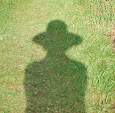While in Oxfam before Christmas, looking for kiddies' books - what a source! - I bought myself this wonderful book which I have now just finished. The weather has been awful so nothing for it but to start on the To Be Read pile of books at the bedside!
 Having spent hours - nay, years - on a boat looking at, and, indeed, taking photos of clouds, I found this book a good source for learning about Cloud Nomenclature. Yes, there is a Linnaean classification system for which I (a) heartily approve and (b) regret I never learned at the time of learning the Kingdom/Phylum/Order/Family/Genus/Species for plants and animals all those years ago.
Having spent hours - nay, years - on a boat looking at, and, indeed, taking photos of clouds, I found this book a good source for learning about Cloud Nomenclature. Yes, there is a Linnaean classification system for which I (a) heartily approve and (b) regret I never learned at the time of learning the Kingdom/Phylum/Order/Family/Genus/Species for plants and animals all those years ago. Crepuscular rays shining above the Stratocumulus. Photos taken at Dobbie's Garden Centre, Bearsden, in the autum afternoon. The light is scattered by particles and droplets in the atmosphere. (So now you know...)
Crepuscular rays shining above the Stratocumulus. Photos taken at Dobbie's Garden Centre, Bearsden, in the autum afternoon. The light is scattered by particles and droplets in the atmosphere. (So now you know...) This is officially known at a Tuba. This photo was taken by Elisabeth Scott, aboard Monkey Business, on their trip across the North Sea to Norway last summer. The book states, "In and around downdraughts associated with large Cumulonimbus and Cumulus congestus clouds, a vortex of swirling air can develop like that in water draining down a plug hole. ... It is a column or tube of cloud extending down the middle of one of these vortices."
This is officially known at a Tuba. This photo was taken by Elisabeth Scott, aboard Monkey Business, on their trip across the North Sea to Norway last summer. The book states, "In and around downdraughts associated with large Cumulonimbus and Cumulus congestus clouds, a vortex of swirling air can develop like that in water draining down a plug hole. ... It is a column or tube of cloud extending down the middle of one of these vortices."

Ralph Waldo Emerson described the sky as "the daily bread of the eyes ... the ultimate art gallery above". Journal, May 25 [?18th], 1843.
So what was Mantegna doing here* when he painted the clouds in the background of this painting of St Sebastian? The small picture shows a rider in the clouds at the upper left corner of the larger painting. The cloud is white and the rider has a scythe, which he is using to cut the cloud. The rider is Saturn who in ancient times was identified with Time ... i.e. time is passing.
So what was Mantegna doing here* when he painted the clouds in the background of this painting of St Sebastian? The small picture shows a rider in the clouds at the upper left corner of the larger painting. The cloud is white and the rider has a scythe, which he is using to cut the cloud. The rider is Saturn who in ancient times was identified with Time ... i.e. time is passing.
____________________________________________________________________
*Andrea Mantegna, St Sebastian, 1459-60, on wood, Art History Museum, Vienna. (Wikipedia)




No comments:
Post a Comment